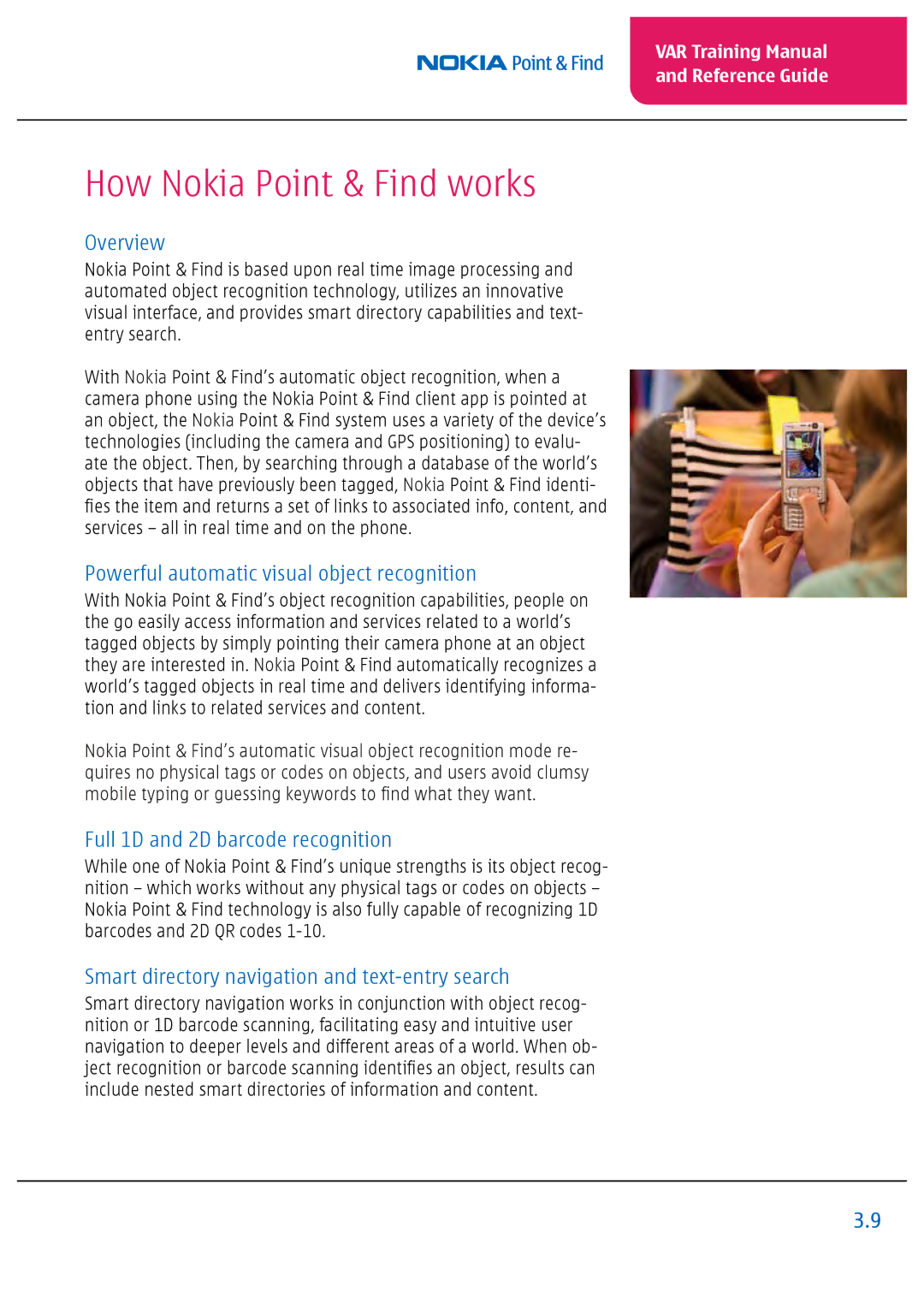Nokia Point & Find
Version
Table of Contents
This page intentionally left blank
Nokia Vision Commitment
Nokia Vision and Commitment
Nokia is committed to lead in mobile Internet services
Nokia is the global leader in mobile devices
Nokia facts and figures
Point Find
Chapter Overview
Chapter briefs
Chapter Overview
Using the Nokia Point & Find Client App
How to use this manual
Chapter Overview
Nokia Point & Find Story
Mobile discovery on demand
Easy, intuitive, on the spot mobile services
VAR Training Manual and Reference Guide
Big picture on the mobile information services market
Nokia Point & Find scenario
What will become the Google of mobile?
Nokia City Guide Body Worlds Promo World
VAR Training Manual Reference Guide
Essential Nokia Point & Find terms and concepts
Objects or Targets, when tagging
Nokia Point & Find worlds
Labels
Essential terms and concepts recap
Tags
Movies
Nokia branded worlds
Shopping
City Guide
How Nokia Point & Find works
Powerful automatic visual object recognition
Overview
Full 1D and 2D barcode recognition
Nokia Point & Find Versions
GPS and Cell ID for location-based services LBS
Range of result actions
Future technologies and capabilities
Factors for success Nokia Point & Find benefits
Powerful and easy-to-use tools for development
Early stages
New, better, and easier user process
Unique strengths of Nokia Point & Find worlds
Nokia Point & Find delivers breakthrough mobile services
Nokia Point & Find scenarios publishing
Noki Point & Find delivers solutions across segments
Scenario
Nokia Point & Find works with print as is
Jafo Venetian Pumps leather, $79.99
Publisher benefits
Reader benefits
Client Application
Step a Install Nokia PC Suite software on your PC for US
Using Nokia Point & Find client application
Nokia Point & Find devices
Step B Download the client application
Step C Install the client application to your device
Step D Add a Nokia Point & Find shortcut to your device
Directory screen Results screen
Home screen
Launch the client application
Using the Nokia Point & Find client application
Add/Remove world function
Browse saved worlds and select a world to explore
VAR Training Manual Reference Guide
Point at objects for automatic visual recognition
Capturing 1D barcodes
Capture barcodes
Searching within a world with text-entry search
Intro to Creating Nokia Point & Find Worlds
Nokia Point & Find client application
Online Nokia Point & Find Management Portal
Management Portal
Easier and quicker than Web sites
Overview steps to publish a Nokia Point & Find world
VAR Training Manual Reference Guide
This page intentionally left blank
Management Portal
Management Portal tabs
Publishing Worlds With the Management Portal
Sign
Getting started Account registration and login
World Names
Create New World
Create New World
Create and name a world
Billing Information
Nokia Point & Find account types
Manage Worlds
Roles
Directory Folders and Entries
Manage Worlds myWorlds
Dashboard Access
Manage Worlds Settings
World selection dropdown menu
World Selection menu
World Icon setting
World Icon
Tag Location Association
Tag Location Association setting
Global
Country
Cell ID
Cell ID/GPS
GPS Only
Default Search Web Button URLs
Search URL & Web Button URL settings
Search URL setting
Web Button URL setting
Advanced Settings options
Advanced Settings
Activate Camera Viewfinder
Content Location Association
Tagging Rate
Upload Tagged Pictures
Content Location Association setting
Access Management
Manage Worlds Access Management
New Collaborator
Access Rights options
Collaborators Access Level options
Collaborators Access Level
Collaborator Lists
Public Access options
Public Access
What is Access Management?
Access Management FAQ Management Portal
What is a collaborator?
Created this world. Why am I not listed as a collaborator?
How do I know a collaborator’s name?
Some of my access levels are grayed out. Why?
Organise Directories
Manage Worlds Organise Directories
Organise Directories options
Root Folders Root Entries
Creating and naming Directories, Root Folders, and Entries
Saving Your Work Organise Directories
Creating and naming Directories, Root Folders, and Entries
Root entry is an entry in a Directory’s highest level
Creating and naming Root Entries
Creating and naming Root Entries
Import Directory
Export Directory
Delete Directory
Manage Tags
Manage Worlds Manage Tags
View tags by region
Manage Tags options
Tag search box
Time-based search filter
Basic functions
Edit tag label
View tag image
Staging Worlds
Tag Management
Selector and Tag Counter
Select All
Defining Tag Result Actions
PX Parameters
Account tab
Support tab
Download tab
VAR TrainingChapterManual7
Create a world and purchase an account plan
Before Tagging Objects
Content Location Association
Enable collaborators Access to generate tags for your world
Set your Tagging Rate
Create your world’s directory structure and object labels
Check your device’s GPS connection
Essential preliminaries with your mobile device
Enable your mobile device for tagging
Launch the client application and select world
Check tag download and server connection
What does Guest Access Disabled mean?
What does Guest Access Enabled mean?
Tagging with Repeat Tagging Rate
Make tagging easier
Using the Cancel Key during tagging
Tagging with Single Tagging Rate
VAR Training Manual Reference Guide
Helpful pointers for tagging

